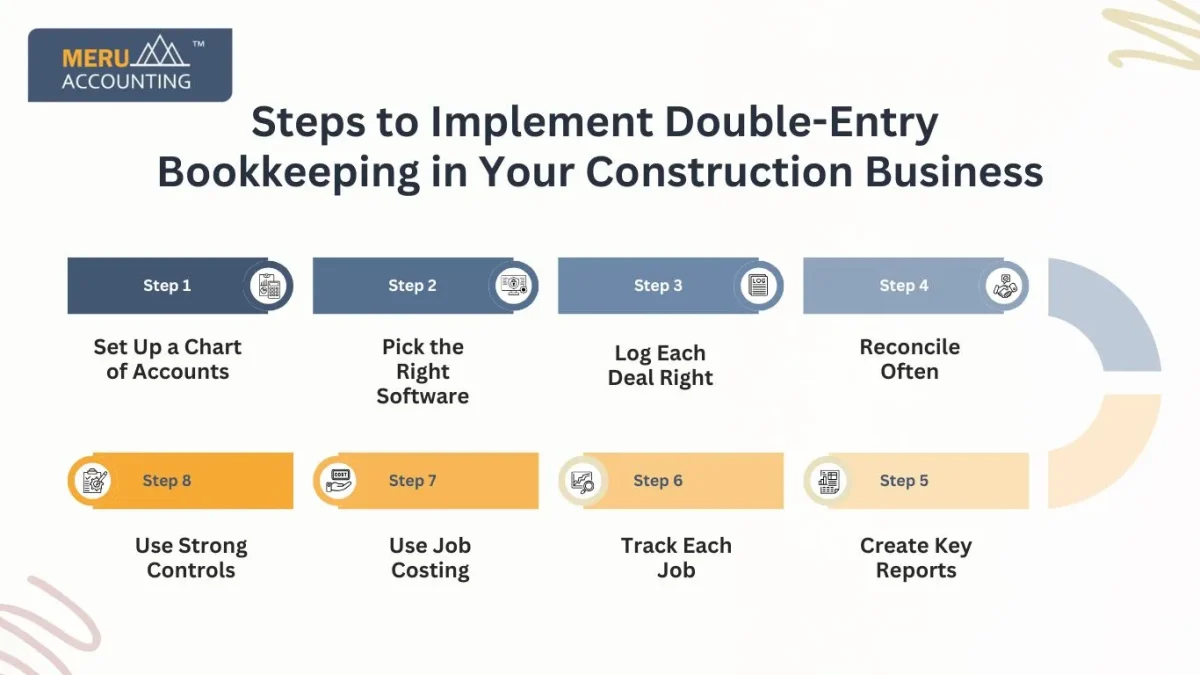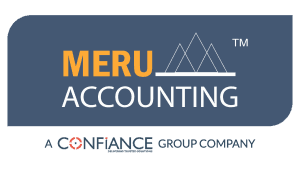How to Implement Double-Entry Bookkeeping in Your Construction Business
Using a double-entry bookkeeping system in your construction firm is key to keeping good records and making smart money choices. This method tracks each deal in two accounts, giving a full view of your firm’s cash and costs. It also helps you spot errors and keep your books in check.
This system works well for construction work, where jobs often have many costs and steps. With it, you can track income, job costs, and more. This helps you stay on budget, manage funds, and meet tax rules.
Steps to Implement Double-Entry Bookkeeping in Your Construction Business
1. Set Up a Chart of Accounts
Make a clear list of all the accounts your firm will use. Group each deal by type:
- Assets: Cash, tools, unpaid bills from clients
- Debts: Loans, unpaid bills you owe
- Equity: Owner’s funds, saved profits
- Income: Job payments
- Costs: Wages, tools, hired help, rent
2. Pick the Right Software
- Pick software that supports Double-Entry Bookkeeping. Use tools made for this type of bookkeeping. Many fit the needs of builders and can save time, cut errors, and help with rules.
3. Log Each Deal Right
- Each deal needs a match — a debit and a credit. If you buy tools, you log the cost and also show that you owe or have paid. Each deal must be true and fit the right account.
4. Reconcile Often
- Check your books with bank and vendor records to catch and fix errors fast. This keeps your books true.

5. Create Key Reports
- With Double-Entry Bookkeeping, you can create accurate reports. Use your software to make reports like:
- Profit Report (Income Statement): Shows money made and lost
- Balance Sheet: Shows what you own and owe
- Cash Flow Report: Tracks money in and out
6. Track Each Job
- Use this system to track each job’s costs, like staff, tools, or outside work. This helps you stay on track and see which jobs bring in cash.
7. Use Job Costing
- Link each cost to the right job. This helps you check job profit and see where you spend too much.
8. Use Strong Controls
- Keep your data safe. Set clear roles so each person knows which tasks they have to do. Use checks, limits, and reviews to keep your books clean and safe from fraud.
Importance of Double-Entry Bookkeeping in Construction Business
1. Better Record-Keeping
- Full Picture: Each deal is logged twice — once as a debit and once as a credit. This gives a full and fair view of your cash and costs.
- Fewer Mistakes: Deals must match on both sides. This helps you catch and fix errors fast.
2. Cash Flow Control
- Track Cash: You can see money in and out, which helps you cover bills and plan for job costs.
- Manage Payments: You’ll be on top of bills, pay steps, and when to send or get paid.
3. Job Cost Checks
- Track Job Costs: You can log costs by job, like pay, tools, and work from other firms.
- Spot Overruns: You’ll see if costs go over and can act before it hurts your profit.
4. Meet Rules and File Taxes
- Stay Legal: This method keeps records that meet tax and law rules.
- Easy Tax Time: With clear books, tax time is less work and less risk of fines.
5. Smart Business Moves
- See the Big Picture: You get key reports like balance sheets and income statements.
- Make Good Picks: With clear facts, you can plan bids, invest, or adjust jobs well.
6. Stop Fraud and Errors
- Check and Match: Deals must line up on both sides. It allows for quick error detection by ensuring all entries are balanced and easy to review.
- Cut Risk: The system is clear and safe, so bad or fake deals don’t slip by.
Benefits of Using Double-Entry Bookkeeping in Construction
Clear View of Project Profits: You can see which jobs are profitable and which are not.
Easier Tax Filing: All records are organized and ready for your accountant.
Builds Trust with Investors: Well-kept records show your business is stable and reliable.
Saves Time and Money: Automation in accounting software cuts manual work and costs.
Tracks Payables and Receivables: You can easily see who owes you money and what bills you need to pay.
Helps Plan for the Future: Your reports give insights into business trends, helping you plan future projects or expenses.
Tips for Smooth Implementation
Start Simple: Create basic accounts first. Add more categories as you grow.
Hire a Bookkeeper if Needed: If it’s too complex, hire someone to help set up your system.
Review Reports Regularly: Check monthly reports to spot problems early.
Use Mobile Apps: Log expenses and check accounts on the go using mobile-friendly tools.
Train Your Team: If your team handles receipts or purchases, train them on how to track and record properly.
Schedule Regular Bookkeeping Time: Block out time weekly or biweekly to update your records consistently.
It takes work to set up double-entry bookkeeping, but it’s worth it. It helps you stay in control, make smart choices, and grow your firm. Meru Accounting can help set up your system the right way and make sure you get the most from it. With the right setup, you can boost profit, stay on top of job costs, and grow your firm with ease.
FAQs
- What is double-entry bookkeeping?
It’s a way to track money where each deal is logged in two places. One account gets a debit, and another gets a credit. This keeps your books balanced. - Why does it matter for builders?
It helps you track cash, job costs, and profits. It also helps you follow tax rules and make smart choices. - Can small firms use it too?
Yes. Even small firms can use it. Good software makes it easy and saves time. - What is a chart of accounts?
It’s a list of all account types your firm uses, like:
- What you own (cash, tools)
- What you owe (loans, bills)
- Owner’s money
- Job pay
- Costs (wages, rent, tools)
- How often should I check my books?
Check your books each month. Match them with bank records to spot mistakes early. - What is job costing?
It means tracking all costs for each job, like tools, wages, or outside help, to see if the job made or lost money. - How can software help?
It tracks each deal, builds reports, and helps keep your books in good shape. It helps you save valuable time and reduces errors.








